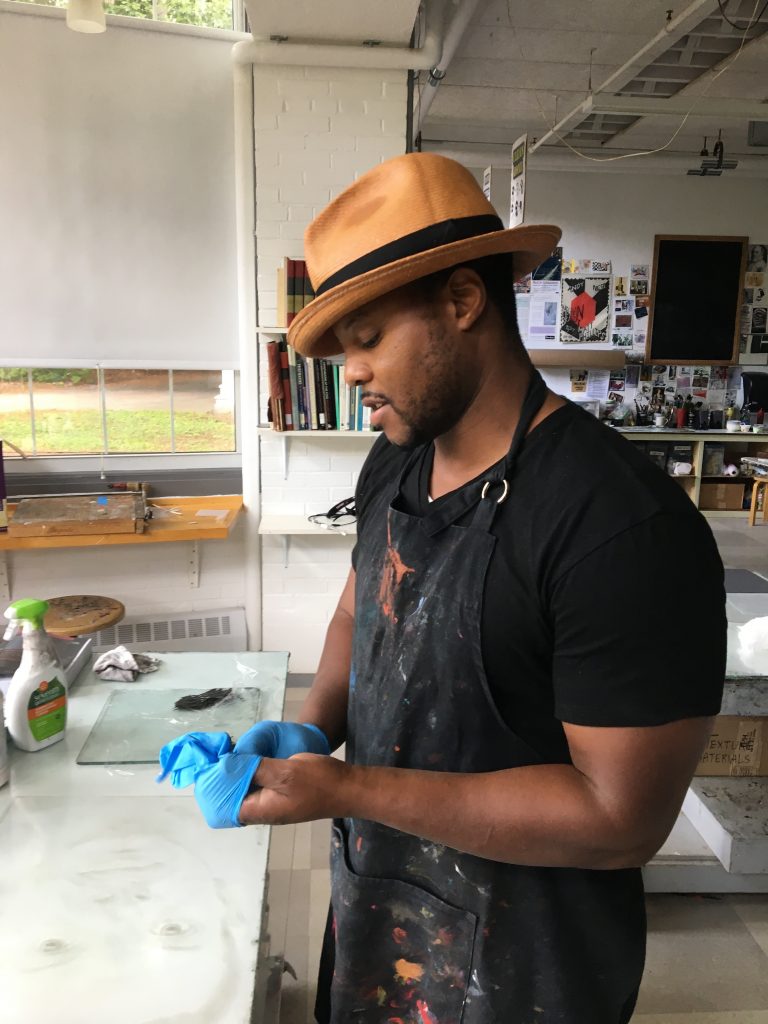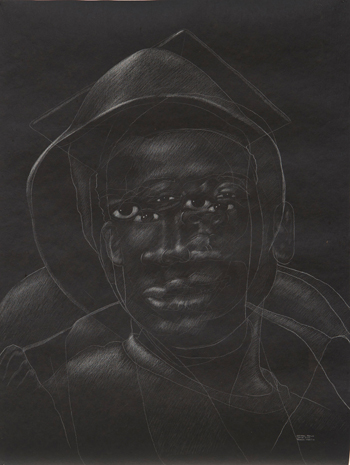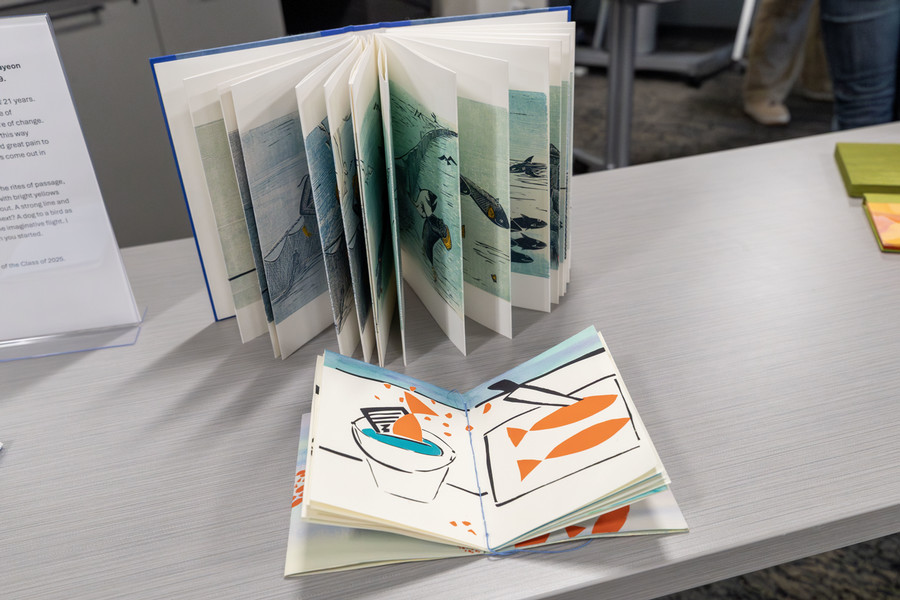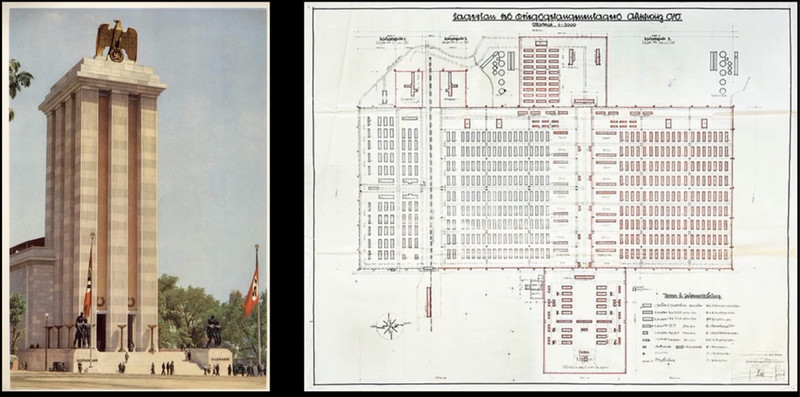Visiting Artist Titus Kaphar Rediscovers the Joy of Printmaking
By Tom Porter
Known primarily as a painter and a sculptor, Kaphar often draws on the past and mixes the work of Classic and Renaissance artists to ask questions about how history is interpreted.
When he arrived at Bowdoin in early August for a three-week stint as the halley k harrisburg ’90 and Michael Rosenfeld Artist-in-Residence, Kaphar was expecting to work on some of his paintings, start some new ones, and maybe do a little bass fishing in his spare time. But, he said, it didn’t quite work out like that.
“As a painter, I have to get acclimatized to a new studio before I can really be productive, and given that I was only going to be here for three weeks, I made the decision after one week to make use of the printmaking studio here and try to make some etchings.” He hadn’t made etchings since graduate school, said Kaphar, but had always really loved them. “Being in a new place, it seemed like a good idea to try something new that I had no expectations or curriculum for.” As it turned out, Kaphar’s foray into printmaking took him in an exciting new direction—and proved more fulfilling than his efforts at bass fishing!
Printmaking rediscovered
With the help of Art Department technician Isaac Jaegerman ’16, Kaphar got to work using a technique known as drypoint engraving. “Isaac prepped a plate for me and I just started drawing on it with an engraving needle. He had seen my drawing in the Bowdoin College Museum of Art, which is chalk on black asphalt paper, and said he thought that would work well as an engraving.” The work in question is The Jerome Project (Asphalt and Chalk) XI (2015), which features three overlaid portraits of Michael Brown, Trayvon Martin and Tamir Rice.

Kaphar described the drypoint technique as similar to drawing, but at the same time notably different. “In some ways it’s more like sculpture because you’re removing material to create the image. It’s a reductive sculptural process rather than an additive drawing process. It was really exciting to make those prints, manipulate the process, to add and take away things.”
He likes the directness of drypoint engraving, which contains fewer steps than regular, traditional printing. “You just make the marks on the plate and print it, whereas other techniques require you to coat the plate with wax or asphalt rather than scratch into it, then put it in a bath of acid for thirty minutes before taking it out, cleaning it, then printing it.”
Printing is much more process-based than painting, and Kaphar admitted this aspect had put him off the medium in the past: “The first people who taught me this seemed more interested in the process than the content, and this discouraged me because for me the content comes first. That’s what has been so great about working here with Isaac,” he said. “He had a natural sense of my aesthetic and helped me achieve what I wanted to.”
What about the works of art themselves?
During his time here Kaphar created dozens of engravings, most of them anonymous portraits based on the mugshots of African American people caught up in the criminal justice system. Highlighting the need for reform of that system has been a prominent feature of Kaphar’s work in recent years, since he embarked on a series of works called The Jerome Project (which includes the drawing mentioned above).
The project came about when he was researching the prison records of his father, who is named Jerome. Kaphar came across many other men who shared his father’s name, and their mugshots inspired him to paint several portraits. All them are of African American men, and Kaphar is aiming to make a point about what he calls the inherent racial bias of the prison industrial complex.
It was a theme continued during his residency at Bowdoin, when Kaphar invited his friend Reginald Dwayne Betts, a noted poet, memoirist, legal campaigner and former convict to join him in an informal collaboration. “He came to visit with his wife and kids, and we decided to get together and see what would happen.” The result is a striking series of works combining Kaphar’s etchings with words printed over the top of them—poems composed by Betts during his stay here.
Betts, who last year earned a law degree from Yale, experimented with a letterpress. He also developed a new creative technique, transforming legal documents into poetry by redacting parts of it. The meaning of the document is changed radically, said Kaphar, giving it an entirely new message.




“Our practices are similar. Much of my paintings’ content comes from what’s not there, what’s been taken away. Your first reaction on seeing one is to deal with what’s in front of you, and the second is to contemplate what was there, and why it was removed.” The intention with both his and Betts’ work, said Kaphar, is that you end up paying more attention to it because something is being withheld.
A monumental issue
The issue of what is and isn’t on display artistically brings Kaphar onto a topic that’s been in the news recently and one which he has spoken about publicly: the issue of the removal of public monuments or statues considered to be offensive.
It’s a debate given fresh momentum following the recent violence in Charlottesville, leading to the removal of confederate statues and public memorials across the country. Kaphar is unconvinced that the straightforward removal of a monunment is the best way to go.
“The current debate tends to be binary in nature, about whether a statue should stay or go, but there is another option,” said Kaphar. “If the sculptures are to remain as they are, unaltered, then they should go, but there’s a conversation we’re not having which speaks to the issue of revision. We should consider the option of taking these monuments down off their pedestals, both literally and figuratively.”
Kaphar suggests bringing local artists into the equation to create work to go alongside the monument in question, putting it into some sort of perspective. “Maybe we should create a new government-sponsored project, where artists are brought in to do something that forces a civic dialog. Simply tearing down a monument, leaving nothing in its place and effectively erasing it from history is just as damaging as leaving it there,” he added.
Return to Bowdoin
Kaphar is due to return to Bowdoin College in October to deliver a lecture. He’s not sure what the subject will be yet, but he is excited by the printmaking and (informal) poetry collaboration with Betts that occurred during his time on campus.
All the thirty-plus etchings he made here were heading back to his studio in Newhaven, CT, where he and Betts, who is a neighbor, will decide what to do next. “The process has been so exciting for me and Dwayne that we’re thinking about a way to continue this. We think of this as a template for how we can continue working together. Maybe we’ll engage a master printer to work with us and use these as examples to create a similar series. Or we may try and return to Bowdoin, to work with students on completing a series of these.”
Either way, it’s clear that Titus Kaphar’s involvement with the Bowdoin community will continue to thrive.



